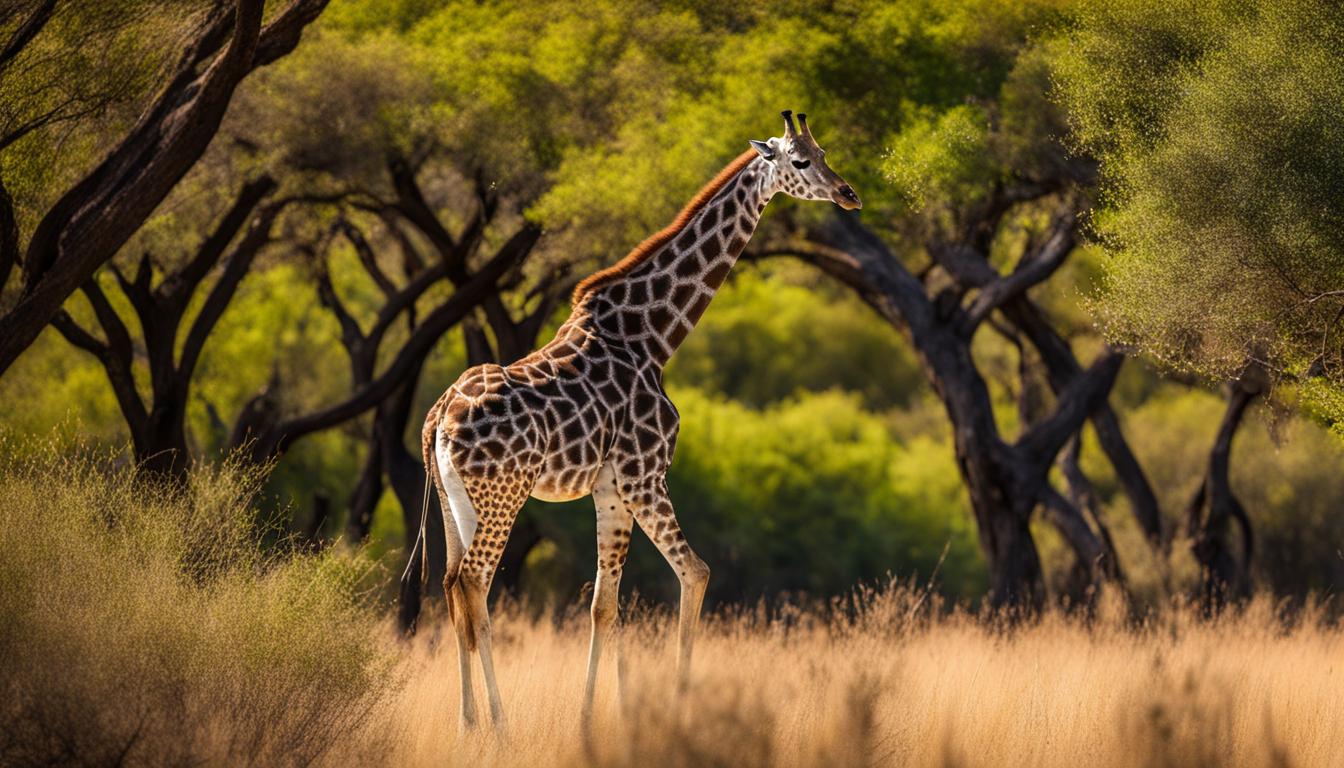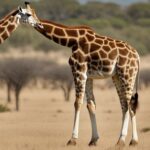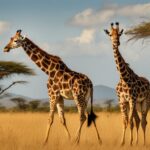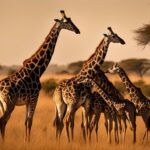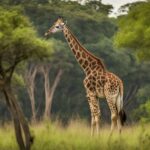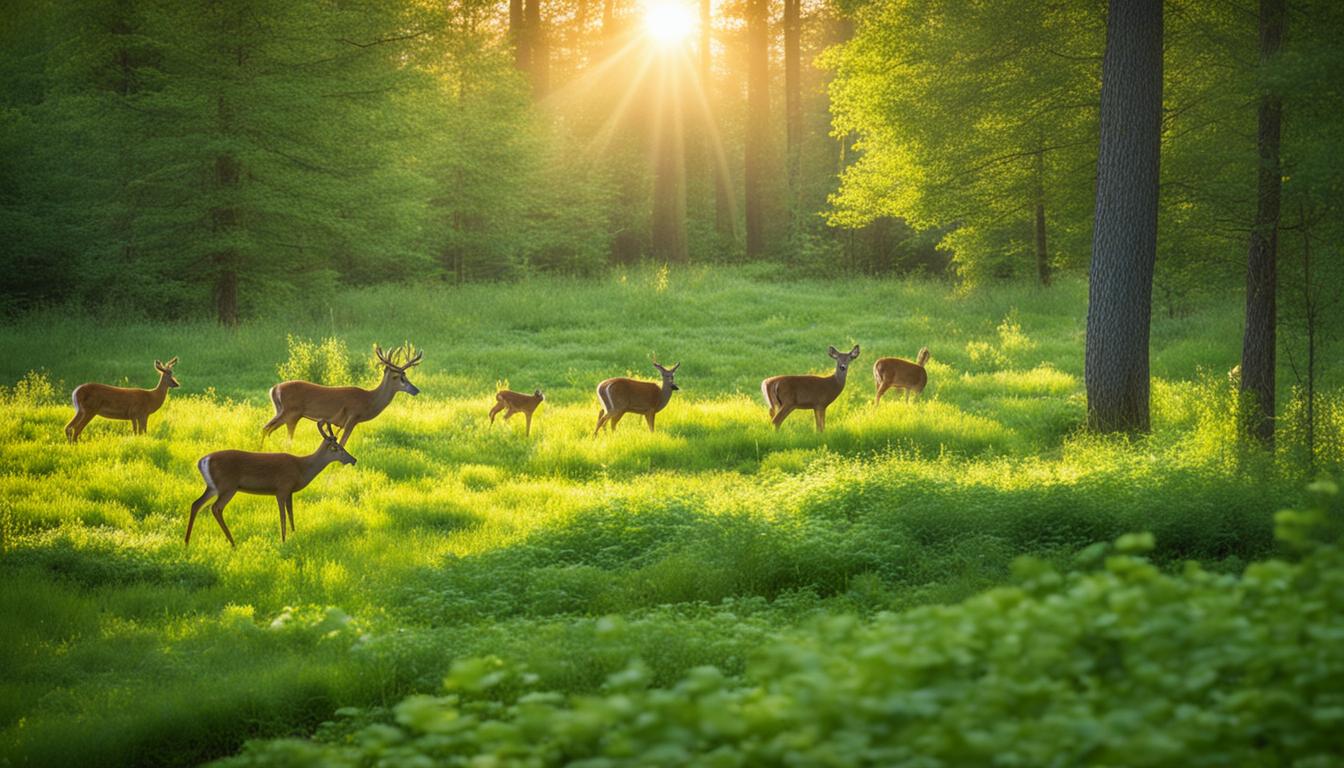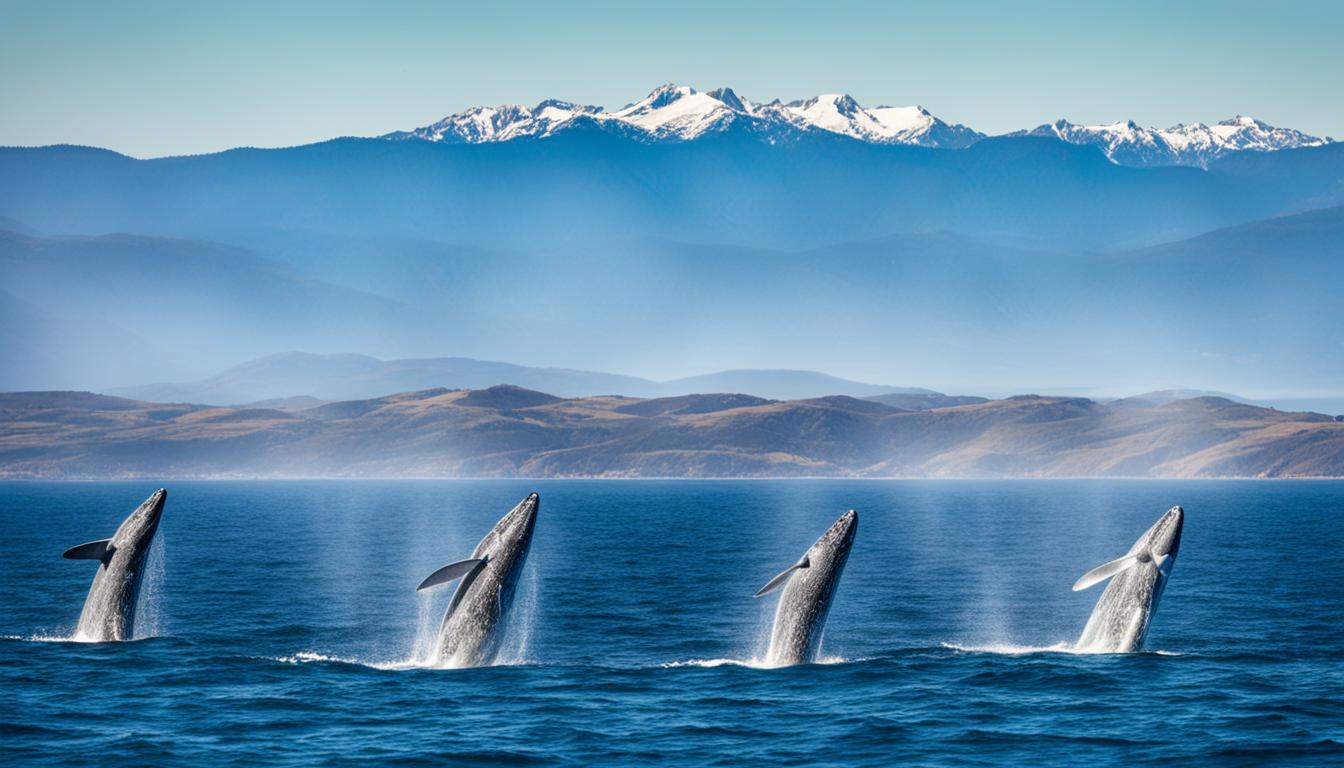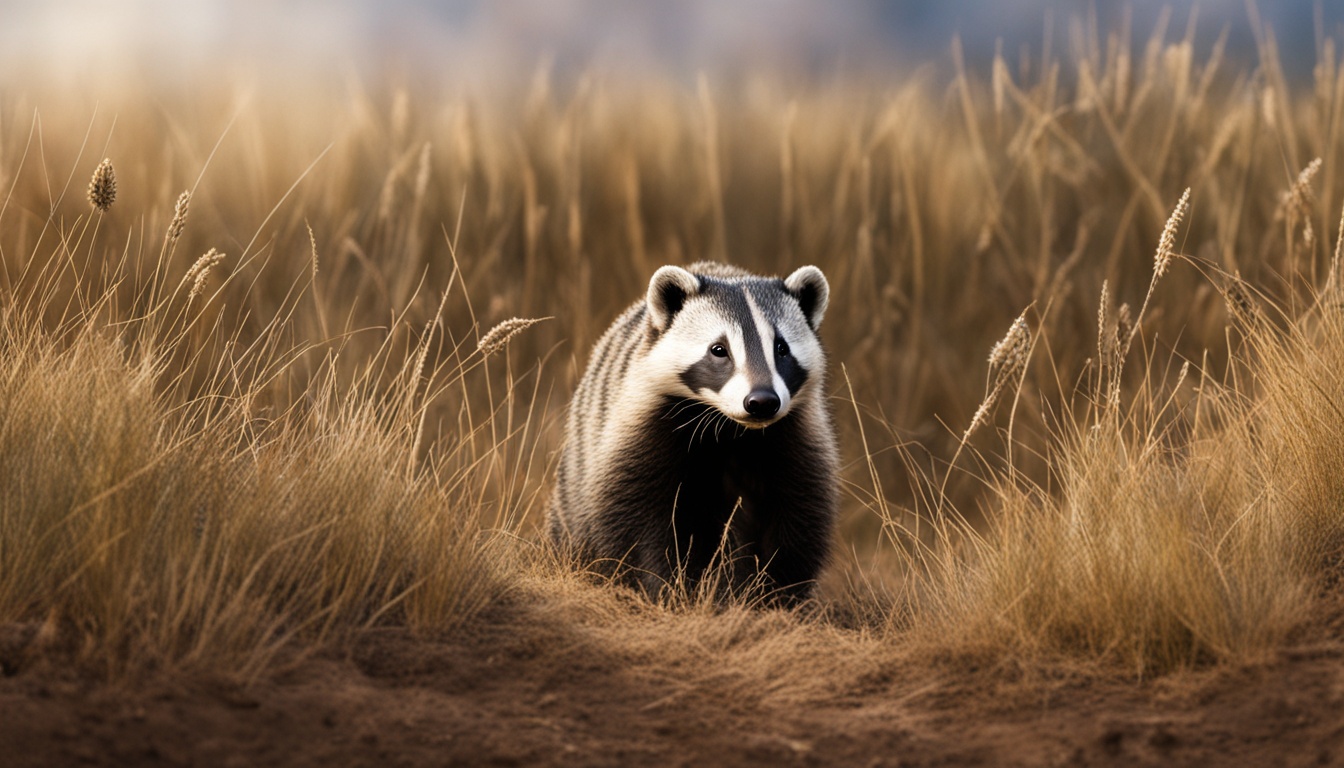Giraffes, with their unique brown and white patterns, are fascinating creatures that capture the imagination. But have you ever wondered where these magnificent animals can be found in their natural habitat?
Well, giraffes are primarily found in Africa, specifically in the sub-Saharan regions. They inhabit a variety of habitats, ranging from semi-arid savannahs to savannah woodlands. These incredible animals have adapted to survive in fragmented habitats scattered throughout sub-Saharan Africa.
With a wide range of subspecies, including the West African, Kordofan, Nubian, reticulated, Rothschild’s, Masai, Thornicroft’s, Angolan, and South African giraffes, giraffes can be found in different parts of Africa, each with its own distinct features.
Exploring the giraffe’s natural habitat is like stepping into a world of wonder and awe. From the open grasslands to the towering trees, these environments provide the perfect backdrop for these graceful creatures.
In the following sections, we will delve deeper into the behavior of giraffes in the wild, the threats they face to their habitat, the population trend, their distribution in national parks, their climate preferences, and the importance of giraffe conservation. So, join us as we embark on a journey to discover more about these incredible animals and their natural homes.
Giraffe Behavior in the Wild
Giraffes, with their incredible height and distinctive coats, possess unique behaviors and adaptations that enable them to thrive in their natural habitat. Understanding giraffe behavior in the wild provides valuable insights into their adaptation to their environment.
One remarkable adaptation is their gestation period of 15 months, one of the longest among mammals. This extended period allows females to give birth throughout the year, ensuring a continuous cycle of reproduction. Females reach sexual maturity between five and seven years, while males reach sexual maturity between seven and eight years.
Being herbivores, giraffes spend a significant portion of their day browsing on a variety of trees and shrubs. Their long necks, which can measure up to six feet, enable them to reach high leaves that other herbivores cannot access. Additionally, their long legs provide them with increased mobility, allowing them to move gracefully across the savannah in search of food and water.
| Giraffe Behavior in the Wild | Description |
|---|---|
| Gestation Period | 15 months |
| Sexual Maturity | Females: 5-7 years; Males: 7-8 years |
| Feeding Habits | Browsing on a variety of trees and shrubs |
| Adaptations | Long necks for reaching high leaves, long legs for mobility |
Giraffes have evolved these behaviors and adaptations over time to successfully adapt to their habitat. Their unique characteristics enable them to thrive in their natural environment, making them one of Africa’s most iconic and fascinating animals.
Giraffe Habitat Loss and the Importance of Protecting Their Environment
Threats to Giraffe Habitat
Giraffes, with their iconic long necks and graceful demeanor, are facing significant challenges due to habitat loss. Human activities, such as uncontrolled timber harvest, agricultural development, mining, poor land-use planning, and urban expansion, have resulted in severe habitat fragmentation for these majestic creatures. As their natural habitats are destroyed or encroached upon, giraffes are left with limited space and resources to thrive.
Poaching also poses a significant threat to giraffes and their habitat. The illegal hunting of giraffes for sport, as well as for their body parts and products, has led to further population decline. Giraffes are hunted for their bushmeat, bones, tail hair, and other valuable body parts, which are often traded on the illegal wildlife market. This exploitation not only harms the giraffe population but also disrupts the delicate balance of their ecosystem.
In addition to human activities and poaching, giraffes are also vulnerable to diseases, collisions with vehicles and aircraft, and the effects of climate change, such as droughts. These additional factors further contribute to the decline of giraffe populations and the degradation of their habitat.
Giraffe Habitat Protection
Protecting giraffe habitat is crucial for the survival of these magnificent creatures and the overall health of their ecosystems. Conservation efforts should focus on preserving existing habitats, restoring degraded areas, and creating protected areas where giraffes can thrive undisturbed.
Enforcing laws against poaching and illegal wildlife trade is essential in preventing further harm to giraffes and their habitat. Collaboration between governments, conservation organizations, and local communities is crucial in implementing effective protection measures and ensuring the long-term survival of giraffes in the wild.
Furthermore, promoting sustainable land-use planning and raising awareness about the importance of giraffe conservation are vital steps towards protecting their habitat. By engaging in responsible practices that prioritize the preservation of giraffe habitats, we can contribute to the conservation of this endangered species and ensure a brighter future for giraffes in the wild.
“Preserving giraffe habitat is not just about protecting a single species; it is about safeguarding the delicate balance of a diverse ecosystem.”
Giraffe Population Trend and Conservation
Giraffe populations have experienced a significant decline over the past few decades. According to the International Union for Conservation of Nature (IUCN), there are currently only around 97,500 giraffes remaining in Africa, representing a decrease of approximately 36-40% over the past 30 years. This decline is primarily due to habitat loss and the various threats faced by giraffes in the wild.
Human activities such as uncontrolled timber harvest, agricultural development, and urban expansion have resulted in the loss and fragmentation of giraffe habitats. This has significantly impacted their ability to find suitable food sources and affected their overall survival. Additionally, poaching for various purposes, including bushmeat and body parts, poses a significant threat to giraffe populations. The impacts of climate change, such as droughts, further exacerbate the challenges faced by these magnificent creatures.
Giraffe conservation is crucial to safeguard the future of these species and their habitats. Efforts are being made to protect and restore giraffe habitats, enforce anti-poaching laws, and promote sustainable land-use planning. Conservation organizations, governments, and local communities are working together to raise awareness about the importance of giraffe conservation and implement strategies to protect these iconic animals.
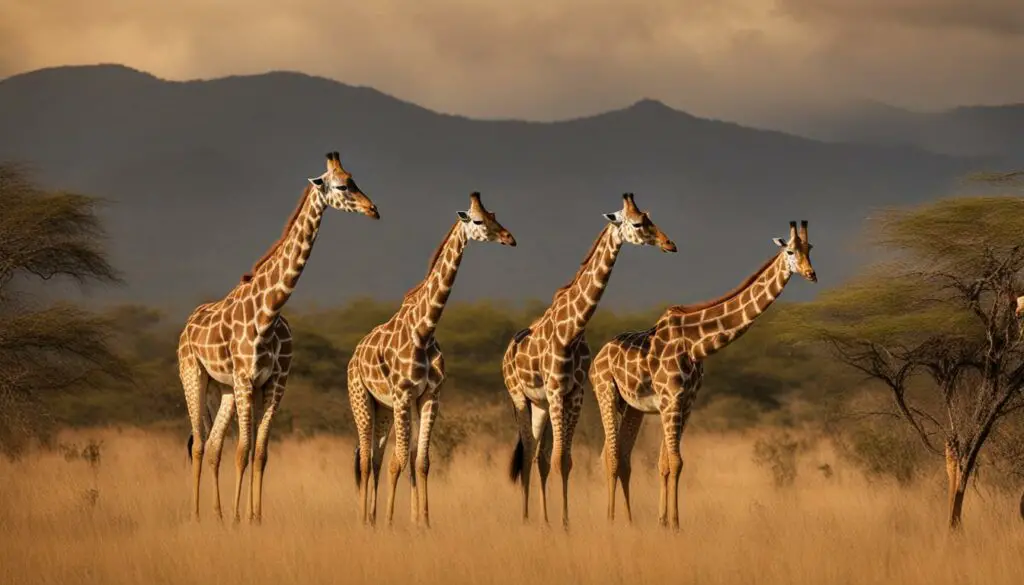
Giraffe Population Trend
| Year | Estimated Giraffe Population |
|---|---|
| 1985 | 150,000+ |
| 2021 | 97,500 |
As depicted in the table above, the giraffe population has declined from over 150,000 in 1985 to approximately 97,500 in 2021. This alarming trend highlights the urgency of conservation efforts to reverse the population decline and ensure the survival of giraffes in the wild.
Giraffe Distribution and National Parks
Giraffes are native to Africa, predominantly the sub-Saharan regions. They inhabit a variety of habitats, including savannas, grasslands, and open forests. While their distribution is fragmented, they have adapted to different environments across the continent. Some of the national parks where giraffes can be found include Lake Nakuru National Park and Tsavo East National Park in Kenya, Murchison Falls National Park in Uganda, Kruger National Park in South Africa, Etosha National Park in Namibia, and Manyara National Park and Mikumi National Park in Tanzania.
These national parks provide protected spaces for giraffes to thrive and are crucial for their conservation. Lake Nakuru National Park, located in Kenya’s Rift Valley, is known for its pink flamingos and diverse wildlife, including the Rothschild’s giraffe. Tsavo East National Park, one of Kenya’s largest national parks, is home to large herds of giraffes, along with elephants, lions, and other wildlife. Murchison Falls National Park in Uganda is famous for its scenic waterfalls and is a sanctuary for giraffes and other savannah animals.
In South Africa, Kruger National Park offers vast wilderness areas where giraffes can roam freely. Giraffes can also be found in Namibia’s Etosha National Park, known for its salt pans and abundant wildlife. Manyara National Park in Tanzania is renowned for its tree-climbing lions and is a habitat for giraffes, elephants, and other animals. Mikumi National Park, also in Tanzania, is part of the larger Selous ecosystem and provides a safe haven for giraffes.
| National Park | Country | Notable Features |
|---|---|---|
| Lake Nakuru National Park | Kenya | Pink flamingos, diverse wildlife, Rothschild’s giraffe |
| Tsavo East National Park | Kenya | Large herds of giraffes, elephants, lions |
| Murchison Falls National Park | Uganda | Scenic waterfalls, sanctuary for giraffes and savannah animals |
| Kruger National Park | South Africa | Vast wilderness areas, diverse wildlife |
| Etosha National Park | Namibia | Salt pans, abundant wildlife |
| Manyara National Park | Tanzania | Tree-climbing lions, habitat for giraffes, elephants |
| Mikumi National Park | Tanzania | Part of the Selous ecosystem, safe haven for giraffes |
Visiting these national parks provides opportunities to observe giraffes in their natural habitat and learn more about their behaviors and adaptations. It also serves as a reminder of the importance of protecting these environments to ensure the survival of giraffes for future generations.
Giraffe Habitat and Climate Preferences
Giraffes are majestic creatures that thrive in specific habitats and climate conditions. Understanding their preferences is crucial for conservation efforts and ensuring their long-term survival in the wild.
Giraffes are primarily found in areas with hot climates and wide open spaces, allowing them to spot predators from a distance and roam freely. They prefer habitats like savannas, grasslands, and open forests, where they have access to tall trees for food. Contrary to popular belief, dense forests are not ideal for giraffes as they need space to maneuver due to their height.
The constant expansion of human activities, habitat destruction, and climate change have led to shrinking giraffe habitats and reduced food sources. This poses a significant threat to their survival and emphasizes the urgent need for conservation efforts.
Giraffe Habitat and Climate Preferences
Table:
| Habitat Type | Location | Key Features |
|---|---|---|
| Savannas | Sub-Saharan Africa | Wide open spaces, abundant vegetation |
| Grasslands | Sub-Saharan Africa | Rich grasses, sparse tree cover |
| Open Forests | Sub-Saharan Africa | Tall trees, scattered undergrowth |
Giraffes have evolved over time to adapt to their specific habitat and climate conditions. Preserving their natural environments and ensuring sufficient food sources are essential steps in the conservation of giraffes. Collaborative efforts between governments, conservation organizations, and local communities are necessary to protect and restore their habitats, enforce anti-poaching laws, and promote sustainable land-use practices. By taking action to safeguard giraffe habitats, we can contribute to the long-term survival of these magnificent creatures.
Conclusion
Giraffe conservation is of utmost importance to protect these magnificent creatures and prevent further population decline and habitat loss. It is crucial that we take action to preserve their habitats and ensure their survival in the wild.
Efforts to protect giraffe habitats should be prioritized, and laws against poaching must be strictly enforced. Additionally, promoting sustainable land-use planning is essential to prevent further degradation of giraffe habitat.
Collaboration between governments, conservation organizations, and local communities is key in safeguarding the future of giraffes. By working together, we can raise awareness about the importance of giraffe conservation and implement effective strategies to protect their habitats.
Let us join hands in protecting giraffe habitat and securing a thriving future for these majestic creatures. Together, we can make a difference in giraffe conservation and ensure that these incredible animals continue to roam the African savannah for generations to come.
Do the locations where giraffes are found in the wild also experience the primary threats to giraffe populations?
Many locations where giraffes are found in the wild do experience the primary threats to wild giraffes. These threats include habitat loss, illegal hunting, and human-wildlife conflicts. Protecting these locations and addressing the primary threats are crucial for the conservation of giraffe populations in the wild.
FAQ
Where can giraffes be found in the wild?
Giraffes are native to Africa, predominantly the sub-Saharan regions. They can be found in habitats such as savannas, grasslands, and open forests. Some national parks where giraffes can be found include Lake Nakuru National Park and Tsavo East National Park in Kenya, Murchison Falls National Park in Uganda, Kruger National Park in South Africa, Etosha National Park in Namibia, and Manyara National Park and Mikumi National Park in Tanzania.
What is the behavior of giraffes in the wild?
Giraffes spend a large part of their day browsing on a variety of trees and shrubs. They have adapted to their habitat by having long necks to reach high leaves and legs for mobility. They have a home range of 8 to 50 square miles and require habitat that provides them with space to maneuver due to their height.
What are the threats to giraffe habitat?
Giraffes face threats to their habitat, including habitat loss and fragmentation due to human activities such as uncontrolled timber harvest, agricultural development, mining, poor land-use planning, and urban expansion. They are also hunted for sport and for their parts and products, leading to poaching. Diseases, inbreeding depression, collisions with vehicles and aircraft, and the impacts of climate change further contribute to the decline of giraffe populations.
What is the population trend of giraffes?
Over the past 30 years, giraffe populations have undergone a significant decline of 36-40%. The current estimate suggests that there are approximately 97,500 giraffes remaining in Africa, a decrease from the 150,000-plus giraffes recorded in Africa in 1985. Conservation efforts are crucial to protect their species and preserve their habitat.
Where are giraffes distributed and which national parks can they be found in?
Giraffes are distributed across sub-Saharan Africa in fragmented habitats. Some national parks where giraffes can be found include Lake Nakuru National Park and Tsavo East National Park in Kenya, Murchison Falls National Park in Uganda, Kruger National Park in South Africa, Etosha National Park in Namibia, and Manyara National Park and Mikumi National Park in Tanzania.
What are the climate preferences of giraffes in their habitat?
Giraffes thrive in areas with hot climates and wide open spaces that allow them to spot predators from a distance. They require access to tall trees for food and prefer savannas, grasslands, and open forests. However, the constant expansion of human activities and habitat destruction have resulted in shrinking giraffe habitats and reduced food sources.
What is the importance of giraffe conservation?
Giraffe conservation is crucial to prevent further population decline and habitat loss. Efforts to protect giraffe habitats, enforce laws against poaching, and promote sustainable land-use planning are essential. Collaboration between governments, conservation organizations, and local communities is necessary to safeguard the future of giraffes in the wild.

